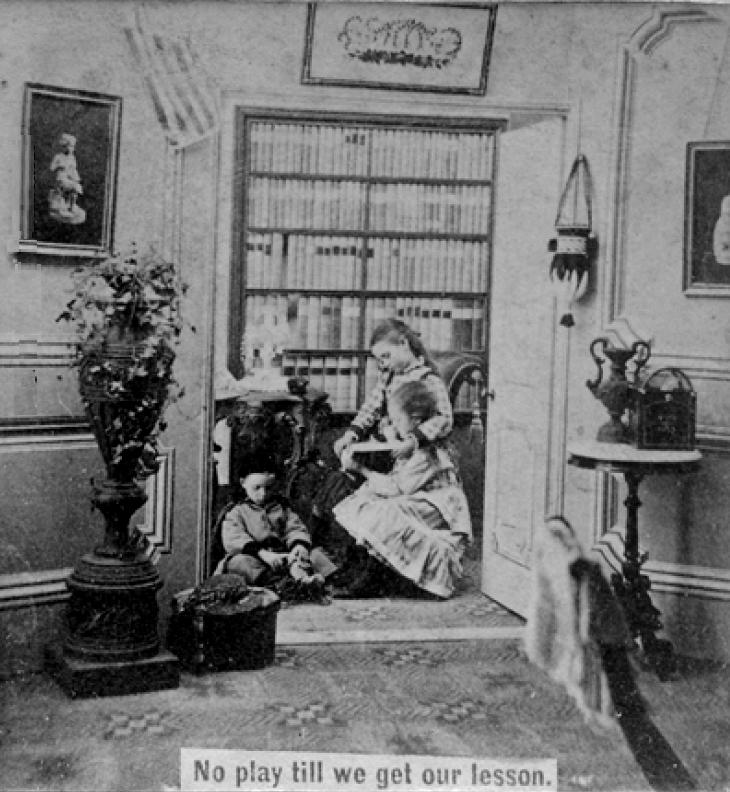
Home Schooling: Chronology

Figure 1.--This stereo view card from the late-0th century was entitled, 'No play till we get our lesson'. It was a series of domestic scenes. The photograph is a studio mock up designed to show an affluent home. At the time, home chooling was mostly an alternative for the well to do. We ee children reading books it what was meant to show a library room. The existence of a fine public school system mean that few working-class or middle-class parents considered home schooling.
|
|
Home schooling is nothing new. Home schooling, although not academic schooling, is as old as humanity and in fact is obsevale in countless anjimals, mostly mammals. In fact, it is public schooling that is the novel development. Public schools did not appear until the 18th century and did not become common place until the late-19th century, at least in Europe. And much later in the developing world. Many European children were not attending public schools even in the early-20th century. One of ghe reasons for America's and Prussia's meteroric development was the early adoption of public duction. There were no public schools in the ancient world, except perhaps in Sparta. And often ignored in ancient and modern texts because of the popularity of Athens and distasteful aspects of Spartan education, was that public education was a factor in Spartan power. Education meaning avademic schooling and not learning the menial or artisan occupations of ones parents was reserved for a small portion of the population, usually the aristocratic ellte. Children in aristocratic and wealthy families were taught at home by tutors. Alexander the Great being taught at home' by none other than Aristotle (4th century BC). That certainly was not the first example of home schooling, but it is the first example in which the identities of the tutor and student are known. Many wealthy Romans were taught by Greek slaves. This did not change for centuries. And when the change came, in came in Europe. There were three reasons why it came in Europe. And all three were associated with Christinaity. First was the attention that the Church gave to education, virtually the only institutin fir centuries promoting eduction and ultimately founding the university system nd the pursuit of science. Second playing a major role in developing the economic system and enabling merchants to achieve important social status. (Merchants in China never had the same status of yhose in the West.) Third as this was primarily a Protestant achuevement. Luther's focus on Bible study meant that ordinary people had to learn to read, And at ghis time, home study was vital. And this meant thst female literacy was vital, because it was often mother that was responsible or younger children and thus did what today would be called primary teaching. This Bible reading empetus was the same dynamic that led to publication, initially only in Protestant countries. Home schooling could occur in poor homes. After all, this was how Abraham Lincoln and many others learned to read. It was well-to-do families that had not only the greatest potential for firmal education, but the greater potential for home scholing. Wealthy families had more time and resiurces to educate their children at home. They could even hire tutors. Home schooling by tutors for the well to was still very common in the early-19th century. And many mothers from more modest families taught their children. Women more commonly remained at home in the 19th century making this possible. Since World War II there have been greater interest in home schooling, especially in America. Some European countries require children to attend school. The interest in home schools is the result of the increasing secularization of society combined with the preceived declining disipline and academic standards in the public schools. Christian fundamentalism is an important factor here, but the home schooling movement is by no means an entirely religious movement.
HBC-SU

Related Chronolgy Pages in the Boys' Historical Web Site
[Main Chronology Page]
[The 1900s]
[The 1910s]
[The 1920s]
[The 1930s]
[The 1940s]
[The 1950s]
[The 1960s]
[The 1970s]
[The 1980s]
[The 1990s]
[The 2000s]
Navigate the Relate Boys Historical Clothing Uniform Garment Pages
[Main garment page]
[Blazers]
[Bookbag]
[Caps]
[Coats]
[Hosiery]
[Kilts]
[Pants]
[Shirts]
[Shoes]
[Smocks
[Suits]
[Seaters]
[Ties]
Navigate the HBC Country School Pages
[Return to the Main home schooling page]
[Return to the Main School Uniform type Page]
[Return to the Main School Uniform Page]
[Return to the Main National School Uniform Page]
[Australia]
[England]
[France]
[Germany]
[Ireland]
[Italy]
[Japan]
[New Zealand]
[Poland]
[Singapore]
[Scotland]
[Singapore]
[United States]
Navigate the HBC Scool Section:
[About Us]
[Activities]
[Chronology]
[Clothing styles]
[Countries]
[Debate]
[Economics]
[Garment]
[Gender]
[Hair]
[History]
[Home trends]
[Literary characters]
[School types]
[Significance]
[Transport and travel
[Uniform regulations]
[Year level]
[Other topics]
[Images]
[Links]
[Registration]
[Tools]
[Return to the Historic Boys' School Home]
Created: 1:44 AM 5/4/2018
Last updated: 1:44 AM 5/4/2018




